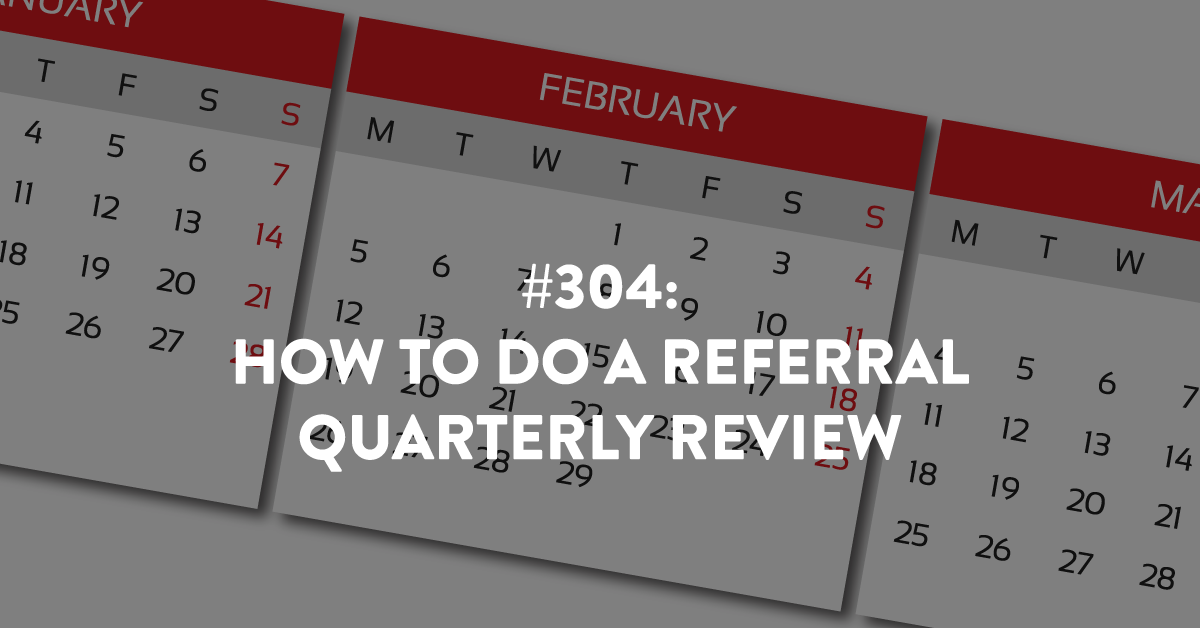Ep #304: How to Do a Referral Quarterly Review
To ensure the success of your referral strategy, conducting a quarterly review is essential. This episode walks you through how I teach my clients to conduct a referral quarterly review. Below are some key highlights.
Importance of Quarterly Review:
- Quarterly reviews allow you to assess the effectiveness of your referral strategy over a specific period.
- They provide insights into the number of referrals received, closed, and in process, helping you understand the referral pipeline.
- Quarterly tracking referrals helps to identify trends, patterns, and areas that need improvement in your referral process.
- It helps measure progress toward your referral goals and make informed decisions based on the collected data.
Metrics to Track on a Quarterly Basis:
- Total Number of Referrals Received: Keep track of the total number of referrals received during the quarter to gauge referral activity.
- Referrals Closed into Paying Clients: Monitor the number of referrals that convert into paying clients to assess the conversion rate.
- Referrals in Process: Track the referrals still in the pipeline with the potential to convert into future clients.
- Revenue Generated from Referrals: Measure the revenue generated from referrals received during the quarter to evaluate the financial impact.
- Number of New Referral Sources Added: Record new referral sources added during the quarter to expand your referral network.
By consistently monitoring these key metrics quarterly, you can understand your referral performance, identify trends, and make data-driven decisions to optimize your referral strategy for greater success.
As always, if you have any questions or need further guidance on building a referral strategy that works for you, feel free to reach out. I’m here to help you succeed!
Links Mentioned During the Episode:
Learn how to work with me inside my Building a Referable Business™ coaching program. Check out the program and then apply to see if you’re a fit.
Want me to build your Referral Strategy for you? Then check out my VIP Referrals In A Day service where I handle the heavy lifting for you. First step is to apply to see if you’re a fit and then we’ll schedule a call. (*A minimum of a 2-person team is required for this Done-For-You service.)
Next Episode:
Next episode is #305, which is another episode created with you and your needs in mind.
Download The Full Episode Transcript
Read the Transcript Below:
Stacey Brown Randall: Welcome to the second quarter. It’s time to do a review. But specifically, I’m going to show you how I teach my clients to do a referral quarterly review. Let’s dive in.
Hey there, and welcome to episode 304 of the Roadmap to Referrals podcast, a show about helping you build a referable business. I’m your host, Stacey Brown Randall. My journey from a business failure to a successful business now more than 10 years in, I know generating referrals naturally and consistently has made all the difference. Working with clients around the world, we leverage the science of referrals, protect relationships above all else, and help you build a referral business.
Hey, real quick, before we dive into this episode, our 30 Ways to Take Control of Your Referrals is live, and we are on day nine. So you can join us on social media. Just look for my profiles on LinkedIn, Instagram, or Facebook, and find your daily tiny tip. One small thing you can do to start building the best foundation for referrals in your business.
And there’s 30 of them. I release one every single day. And as we get closer to the end of this month, the end of April 2024, you’ll also be able to download an infographic that shows you all 30 ways. So if you missed one, don’t worry. You can find them now on my social media platforms.
Just look for me at Stacey Brown Randall. And then of course you can download the infographic and keep that information tidy and tucked away so you can always have it when you need a refresher on 30 Ways to Take control of Your Referrals. Join me on social now.
So it’s the start of our second quarter. I’m going to walk you through a referral quarterly review. This is what I teach my clients to do inside my Building a Referable Business Coaching program, and of course, with my VIP Referrals in a Day clients.
Well, let’s first talk about, before we talk about the how you do a quarterly review for referrals, let’s talk about the why.
So I believe that a referrals quarterly review actually fits into a bigger picture of how and what you should be reviewing within your business. I think at the start of every quarter, you should look back at how the last three months went in your business.
This doesn’t need to be like a day-long process or even a half a day process, but just taking note, right? And there’s multiple things that I would tell you that you should be reviewing outside of or in addition to, of course, referrals.
So I think we look at our quarterly review and our business like big picture. So let’s go up to the 30,000 foot view. You’re probably going to want to be paying attention to the clients that you brought on.
So paying attention to how many new clients did you bring in? How many prospects did you have conversations with or were considered prospects? So that way, you know how many prospects did you have over three months? How many of them actually turned into clients? That kind of tells you your closing ratio.
You can also look back to see if you accomplished any of your goals. Maybe you had a smaller task or project you were working on. How much progress did you make on that? Did you finish it? Which is amazing. You should probably do something to celebrate.
Look at any big wins that you had. And of course, maybe some challenges or some struggles that your business had as well. Just kind of looking at that quarterly review.
Now, if you do any larger goal planning or goal setting in your business, so I teach this at the retreat that I do for my VIP and my BRB clients at the end of every year, I spend a little bit of time teaching this proprietary reverse goal setting process that I created more than 10 years ago. And it’s something I’ve been teaching for, well, I guess that long. As long as I started doing it, I started teaching it to my clients as well.
And so when you do a larger goal-setting process, it’s also a good time, I think, at the start of every new quarter to reflect back on, okay, what goals did I set for this year or for bigger than that. I believe you should set goals for, like, five years out.
Then figure out, like, what is your five-year vision? Then map into your three-year milestones so that you’re on pace. And then map into the, okay, what’s my one-year plan, which effectively then becomes your yearly goals. so that you can actually reach where you want to go.
You’re not just setting goals in a vacuum of, what do I want to accomplish this year? It actually matters because it rolls up to where you want to be in five years, making sure you’re on pace. And so if you do something like that, it’s good to start there. Start with your goals.
Then look into, okay, where are we? Are we on pace? Is there anything we were supposed to start quarter two? But also, what did we accomplish in quarter one? Then what did my business actually do in the first quarter of the year?
So you may be looking, like I said, you may be looking at how many new clients did you bring on? You may be looking at how many clients did you retain? You may be looking at, did you launch something new in the first quarter, and how did that go?
You could be looking at how many prospects that came into your world, that filled up in your buyer’s journey, and how many of those actually became paying clients, how many of those are on hold, maybe that’s a not yet, and how many of those said no. So that way you get your closing ratio too.
And then, as I mentioned, also pay attention to the big picture in terms of what did you accomplish? What things did you set out to do that you actually accomplished? What things are gonna be holding over into this quarter, this second quarter as we get started with it?
And then of course, outside of that is now let’s turn our attention to that’s a reflection on how quarter one went and how it rolls up into the bigger picture of what we’re trying to accomplish this year and of course, future years as well.
And then we need to pay attention to where are we going in second quarter. And so I believe that that’s how you do a big picture review. Just like, hey, where am I? What’s happened? Where are we going next?
Now, for my students, I’m going to dig in about the thing that I care the most about, let’s be honest, which is the referrals. And how is that going? And how are they doing?
Here’s the thing. If you’re tracking this correctly and consistently, this should be a very quick review. We do a monthly roundup email that goes out to our coaching clients in particular. And it’s little things like welcoming our new members, and then it’s got the dates of the upcoming weekly office hours or Q&A calls that I do from that perspective. So that’s all there.
And then, of course, there’s always some tips or tidbits. And it always is. Like in the March and the April roundup, it’s like, okay, we’re starting a second quarter. And it’s the same thing when third quarter starts, and fourth quarter starts as well.
But it’s a little bit about, hey, and I always say this to them, if you’ve been tracking the referrals received in the tab that’s in their master spreadsheet dashboard that they have, because my clients all have private Google Drive folders with just me and them.
If you’ve been tracking this, if you’ve been pulling this from your CRM and putting the data into the tracker tab, and if you’ve been updating your tracker tab as well, all of this should be really easy to get to a real quick review of how referrals were for first quarter.
So just to kind of give you an idea of like, why we should be doing this from that perspective, but then also how easy this should be. This will not be easy for you if you haven’t tracked anything and you’re like, I have no idea. I got to go look up who my clients are for this year. I got to go look up who the prospects were that I maybe had conversations with.
I got to go look back on my calendar and see who was on my calendar. Who did I talk to? I got to go figure out what did I actually accomplish because I wasn’t writing anything down. I wasn’t tracking anything. Then this will be hard. I mean, let’s just be honest. I think we need more honesty in our world today. So this won’t be the easiest thing that you do.
But if you are tracking this, it will be easier. So let me now talk about that’s the why you should do it, right? Now, before I talk about the how you should do it, I want to talk about this in two ways.
And one is, what are you tracking on an ongoing basis? And then what exactly does that look like? And what metrics are we paying attention to from a quarterly perspective as well? So let’s dive into how do we do this.
Stacey Brown Randall: Hey there, pardon the interruption. Have you ever wondered how a current member of my Building a Referable Business coaching program would describe their experience in working with me? I did. So I asked them, and here’s what they had to say.
Client: If I had to describe BRB in one word, it would be transformative. It really changes the way that you look at your interactions with the people who can provide business for you.
Client: I would define BRB in one word as a community. It’s always a positive experience. She’s extremely, well, she’s very organized. She makes everything seem easy, even when it’s not actually easy. And she’s extremely motivating.
Client: Defining BRB in one word would be relationships.
Client: BRB, in one word, effective. If you’re looking for an effective program, BRB is it. If you’re looking for a great, knowledgeable expert and cheerleader, then Stacey’s definitely the person to work with.
Client: If I could define BRB in one word, it would be elevate, because it’s certainly elevated my business.
Client: BRB means progress to me. What I would say to someone, the reason to join BRB, is if you’re in a business that’s a referral business, and that’s the most important piece of your business, then I can’t think of a better way to invest in it than invested it in the best authority when it comes to referral business. Stacey.
Stacey Brown Randall: Want to join us inside the coaching program, Building a Referable Business, or BRB for short? Yes? Well, go to StaceyBrownRandall.com/referable to learn all about the program. And then, of course, click on the link that says Apply Now to submit your application. We keep this coaching program small, so we’ve got to make sure you’re the right fit. Your first step is just to apply to see if you’re a fit. And of course, there’s no obligation to join just for applying. OK, now back to the episode.
Stacey Brown Randall: All right, so let’s dive into what you should be tracking with your tracking on an ongoing daily, weekly, monthly basis, and then how that feeds into a quarterly review. So first up, you should have some goals set for your referrals.
So if I’m looking at the first tab, from a master dashboard for my clients, I’m looking at that very first tab. It’s just a Google Sheet. It’s like an Excel spreadsheet. It’s nothing fancy. But I’m looking at it, and it’s like, this is our game plan for the year. We’ve got our goals, and we’ve got our game plan.
And so we map out what we want to accomplish with referral generation for the year. So in this case, for 2024. So we’re going to map out our goals. We’re going to map out the results and the strategies that we need to learn and implement to make those goals a reality. So we’ll have set a 2024 referrals received goal. How many referrals do you want in a year?
Now for my new people who come into BRB, this is typically set by a formula. We set this formula once you get started in the coaching program or VIP. We set this based on your past results.
We’re gonna look back at the last couple of years and we’re gonna be like, what have you been doing with referrals? How many referral sources do you have? Okay, now let’s look at what it would mean to double, triple, or quadruple that number.
And that’s how I get my clients those results you hear us talk about, about it is possible to 2X, 3X, 4X, double, triple, quadruple your referrals. For some in as little as 90 days, and for others, it takes a little bit longer.
But in your first year, that number is, we do that by a formula. That goal for how many referrals you want to receive in your first year, that’s based on a formula of what’s been happening.
But when you’re in your second year, or your fourth year, or your seventh year, whether you’re working with me still in my coaching program, or you’ve graduated, and you’re just continuing to track this stuff because, you know, it works, you want to keep it going, we set a yearly goal.
And sometimes that yearly goal goes up or down based on the previous year, based on what we’re trying to accomplish. So sometimes for folks, it’s not like, oh, I got 50 referrals in my first year. Now I want to get 100. Sometimes they’re like, no, actually I want 30, but I want better quality. So it just depends on your goals.
But we set a goal of the number of referrals you want to receive this year. Then we also make note of how many referral sources, that’s the humans that refer to you, how many referral sources are we starting with. And then, of course, we look at the number of referral sources that we need to add. So that’s our second goal.
So the first goal being, how many referrals do you want to receive this year? And the second goal being, well, how many new people do you need referring you this year? Because that’s going to be indicated by how many people you currently have, you’re starting the year with, versus also how many more referrals you want to receive in a year.
So do you need to add more people, new people to referring you? So that’s our second goal. And then the third goal we’re going to set is your closing ratio goal.
I always tell folks, and I know this sounds backwards, but quantity comes before quality when we’re talking about building a referral strategy. Because what I want you to be able to do is be able to learn how to generate referrals without asking and paying and being gimmicky and promotional.
I want you to learn how to do it. So when you learn how to do it, sometimes we cast just a little bit wider of a net. Right. And so then as you start receiving those referrals and you start doubling and tripling, quadrupling and hitting your goal for that first year, then we really start paying attention to quality.
But first, we do focus on the act of you knowing how to make referrals happen. How do you follow a process? How do you learn a strategy, implement it, do the things you’re supposed to do, do the things, say the things, be consistent, to start receiving referrals?
So I tell folks, I want the referrals to start coming in. I want you to learn those strategies, put them into practice, and have them work for you. Then we’ll turn our attention to, okay, are we getting the right kind of referrals?
And I know for some people are like, whoa, quality over quantity. I know that’s what everybody says. And we do focus on quality over quantity. But it’s not the first thing we focus on. We first focus on you not getting enough referrals, so let’s make sure you know how to do it. Then we can work to cultivate the right kind of quality referrals from your referral sources.
So we will also set a goal. Your third goal that we will set for a year, though this is not on a quarterly basis, is your closing ratio goal. So if you received 50 referrals and you wanted to close 50% of them, well, then did you close 25 of them into clients? That would be the kind of question, did you hit your goal?
So again, the three goals, how many referrals do you want to receive this year? How many new people do you need referring you to help you hit that goal? And then how many of those referred prospects do you actually want to close into paying clients? Those are the three goals we set.
And then, of course, we also go through, and we set strategies that we want to learn that we’re going to need or things we’re going to need to finalize or keep going to get to those three goals. Okay, so that’s kind of like that. I just I felt like I couldn’t talk about how we do a quarterly tracking until I told you how the year looks like.
So that’s like the yearly game plan. Like these are the goals that we set for the year. And then we have a tracker tab. And I had talked about, I’ve talked about tracking ad nauseam. I really do. Let’s be honest of what you should be tracking and why you should be tracking it and how you should be tracking it.
Like, guys, spreadsheet is fine. If you have a CRM, that’s awesome, too. But here’s the things I want you tracking. It’s five columns.
Obviously, I want you tracking the date that that prospect arrived. Then I want you tracking that prospect, that prospective client’s name. I want you tracking the referral source’s name. I want you tracking the outcome. Are they a yes? Are they a no? Or are they a not yet?
And for sometimes, they’re in process for many, many months before you know if they’re a yes or a no or a not yet. And then if they close, then I want to know the revenue, or if you work on commission, the commission that you generated.
And so those are the five columns that I want you tracking. If you’re tracking this, so here’s the thing. Some people use the referral yearly tracker to track all the referrals coming in. They actually track all the prospects.
So they may have the date and the prospect’s name, and then under the source, if it’s a referral source, they’ll put the referral source’s name. But if it came through a different way, like, hey, I met them at a networking event, or this is an old colleague that decided to hire me, or whatever it is, they’ll track that.
So some people use the yearly tracker for referrals received, and they track all prospects. And that’s fine, it’s one way to make it easy, right? But what I’m looking for is to going in and pulling out, okay, how many of those prospects came in that were referrals?
So some use that tracking tab just to collect the referrals received, and some use it to collect all prospects. And then, you know, they’ll go through, and they’ll like bold or they’ll highlight or, you know, pick a color. That’ll be the ones that were actually referred to them.
They won’t be counting, of course, in our goals, the number that maybe they already knew in their network. It has to be referred to them. So they’re going to track those five columns.
And if you’re tracking those five columns and you’re tracking it in January and February and March, when they roll over to their quarterly results tracking tab, they just pop in the numbers. Boop, boop, boop, right? It’s really easy for them to pop in numbers. And so, of course, when we do a quarterly review, we track in a three-month period.
Now, not everybody, because people join the coaching program or VIP at very different times, and so not everybody is tracking like January 1st to March 31st, right, is our first quarter. If you joined April 15th, once you got into the program and you started implementing some of the things, then we would have that date as to when, right?
There’s a moment within a process, depending on which of the two strategies you’re deploying first, that we’re like, okay, this is our start date because now we’re actually doing the thing. So we put that information in, like what was that date?
So it doesn’t have to be like January 1st to March 31st. When you come into my program, it could be April 20th, right? And then three months from then. So it just kinda depends, just kinda keep that in mind.
But we’re doing this like this is a quarterly tracker for my clients, so this is how I would walk them through it. So they have a start date and an end date. So in this case, we’re doing first quarter, so January 1st through March 31st. Then they’re gonna track five things.
Again, they’re all pulling this from the tab prior, but they’re looking at this over a three-month period, right? The first thing is, how many referrals did you receive in this three-month period?
The second thing they’re tracking is how many of those referrals did you close? Meaning how many, right? Review how many of the referrals you received that have said yes to being a client so far.
And there’s an asterisk there because the truth is sometimes you don’t close somebody in three months. I have some people who have a year plus cycle and what it looks like to take a client from prospect to client. And so you have to come back and update that, so not everybody has a client that shows up on January 2nd and they’re closed before March 31st, right? Like it’s just not how it works.
So we do put an asterisk there because we know we have to come back and say, hey, I may have gotten this referral in first quarter, but they closed in second quarter. We always go back and update that quarter that they came in on of what that looks like, even if the revenue was received in a different quarter.
It doesn’t, you don’t change anything about how you do your QuickBooks or your bookkeeping or anything like that. This is just for our tracking mechanism. So a total number of referrals received is the first one. Second one is the number of referrals that closed into a paying client.
The third thing you’re tracking is the number of referrals that are in process. So these are people who haven’t said yes, but they also haven’t said no. They’re in process, right? Like I just mentioned, sometimes you won’t close people in three months. So they kind of have a carryover effect. We just like to track that, how many are in process, right?
And then the fourth thing that we’re going to track is the revenue generated. So we’re just adding up how much revenue did you have in one quarter, right? And then we’re going to also, the last thing we’re going to track is how many new people, new referral sources did you add?
So depending on what strategy my clients are deploying, they’re cultivating referrals from their existing referral sources, while also most of the time cultivating new people to start referring them, which means we have two things we need to make sure that we’re tracking the results on.
So it’s just really easy. Real quick, let me give you a review of those five things we track on a quarterly basis. So you’ve got your start date and your end date. OK, now let’s talk about those five things, and I’ll give you a rundown again.
Number one, total number of referrals received.
Number two, the number of referrals closed into paying clients.
Number three, the number of referrals that are still in process, which means they have potential to close.
Number four, how much revenue did you generate from those referrals received in this quarter?
And then number five, what’s the number of new referral sources that you added?
That’s it. That’s really as simple as it is, right? You’re just tracking a number of things. And then you’re going in and making sure that you’re tracking these things on a monthly basis. And then, of course, at the end of the day, you can pull all those things down if you’re tracking the referrals received on a daily, weekly, and monthly basis.
And you’re just pulling those three months together, and you have your quarterly tracker, your quarterly review. But it’s really important for you to see, are you moving towards your goals? Are you receiving enough referrals? Now we can also start paying attention to quality of referrals.
Closing ratio, are you closing enough? We’ve got strategies to fix everything. Like if you don’t have the right quality, I can solve that, right? If you’re not closing enough of those clients that come to you and they’re actually your ideal client, but you’re not closing enough of them, we got a strategy to solve that.
There are so many situational strategies based on the situation. There’s so many different minor, tiny strategies that we can tweak and add to help you fix what you’re going through. You just got to come join me. You just got to come work with me. Okay. So, but that gives you an overview of how to do it. You guys can do this for yourself.
Alright, let’s wrap up. The show notes page for this episode can be found at StaceyBrownRandall.com/304. That’s for episode 304. And of course, you can find a link to everything that we mentioned in this episode, including the link to join my coaching program or to apply to join my coaching program or to apply to work with me one-on-one in my VIP Referrals in a Day.
We’re back with another great episode next week created with you and your needs in mind. Until then, you know what to do, my friend. Take control of your referrals and build a referable business. Bye for now.







